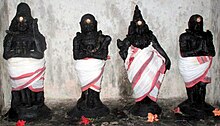Nayanmar

Nayanmar ( Tamil நாயன்மார் IAST Nāyaṉmār [ ˈnɑːjənmɑːr ]) or Nayanar (Tamil: நாயனார் Nāyaṉār [ ˈnɑːjənɑːr ], literally "master") denotes the sixty-three saints of the Tamil Shivaism (Shaiva angiddhanta), those of the Bhaktiakti movement . Their lifespan is dated to the 6th to 11th centuries. The Nayanmar created the Tirumurai , 12 collections or books of Tamil devotional poetry. The last of these books was written by Sekkilar around 1150 and contains the Nayanmar hagiographies . This book is called Periyapuranam and the main part contains the hagiography of Sambandar or Tirunanasambandar, who wrote the first three books and lived in the 8th century. Legend has it that sambandars were abandoned by his father at the age of two and a half in the temple in Sirkazhi . When he began to cry from hunger, Shiva's wife Parvati appeared and nourished her breasts from a golden container with milk. Then Sambandar sang the first stanzas of his poetry with joy .
The first seven books of Tirumurai are called Tevaram and are considered the most important books in this collection. They were composed around the 8th century by three of the Nayanmar, Sambandar , Appar and Sundarar . These seven books contain poems praising Shiva in a particular temple, mostly temples in Tamil Nadu , but some poems also refer to temples in Sri Lanka . The poems contain a diverse mythology of Shiva and his temples, including important pilgrimage sites such as Madurai and Chidambaram , but also lesser-known places.
The eighth book contains the Tiruvasagam and the Tirukkovaiyar , a popular poem in praise of Shiva and mystical love poems to Shiva as it appears in Chidambaram. The remaining books of Tirumurai contain various poems from the Shivaite Bhakti.
The Tirumurai is not used liturgically, but non- Brahmin priests ( Pantaram or Otuvar ) sing the Tevaram at the respective temples described in the Tevaram to supplement the rituals there. Ancient Tamil music probably forms the melodies of these songs while the ragas are contemporary.
See also
literature
- Denise Cush, Catherine Robinson, Michael York (Eds.): Encyclopedia of Hinduism. Routledge, London 2008
